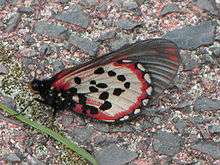Acraea acara
Acraea acara, commonly known as the acara acraea, is a butterfly of the family Nymphalidae which is native to East and southern Africa.
| Acara acraea | |
|---|---|
 | |
| Male | |
_female_(11625310144).jpg) | |
| Female | |
| Scientific classification | |
| Kingdom: | Animalia |
| Phylum: | Arthropoda |
| Class: | Insecta |
| Order: | Lepidoptera |
| Family: | Nymphalidae |
| Genus: | Acraea |
| Species: | A. acara |
| Binomial name | |
| Acraea acara Hewitson, [1865] | |
| Synonyms | |
| |
Range and habitat
It is found in South Africa, Mozambique, Zimbabwe, Zambia, Katanga in the southern DRC, Malawi, Tanzania, and eastern Kenya. In South Africa its range has expanded southwards since 2014, becoming more widespread in the Eastern Cape.[1] The habitat consists of forests and woodland.[2][3]
Description
The wingspan is 55–66 mm for males and 60–72 mm for females.
Biology
Adults are on wing year round in warmer areas, with a peak from November to March. There are multiple generations per year.[4] The larvae feed on Passiflora caerulea, Passiflora edulis, Passiflora incarnata, and Adenia glauca. The spread of the first species, P. caerulea, may have facilitated a range expansion of the butterfly southwards.[1]
Subspecies
There are two subspecies:
- Acraea acara acara – eastern Kenya, Tanzania, DRC: Shaba, Malawi, Zambia, Mozambique, Zimbabwe, Botswana, Namibia, Swaziland, South Africa: Limpopo, Mpumalanga, North West, KwaZulu-Natal, Eastern Cape
- Acraea acara melanophanes Le Cerf, 1927 – northern Namibia
References
- Rautenbach, Fanie (23 April 2018). "Lepimap: 646300". ADU Virtual Museum. Animal Demography Unit. Retrieved 27 April 2018.
- "Afrotropical Butterflies: Nymphalidae - Tribe Acraeini". Archived from the original on 2012-08-10. Retrieved 2012-05-30.
- Underhill, Les. "#citizenscience". Facebook. Animal Demography Unit. Retrieved 27 April 2018.
- Woodhall, Steve (2005). Field Guide to Butterflies of South Africa. Cape Town, South Africa: Struik. ISBN 978-1-86872-724-7.
| Wikispecies has information related to Acraea acara |
| Wikimedia Commons has media related to Acraea acara. |